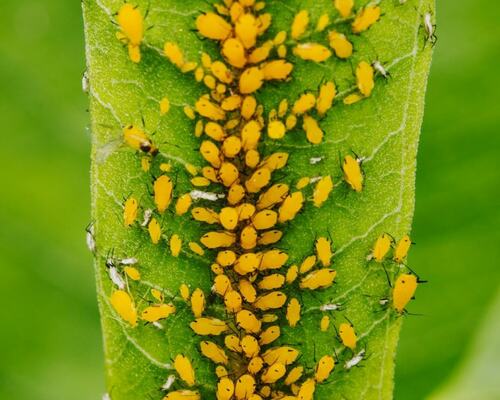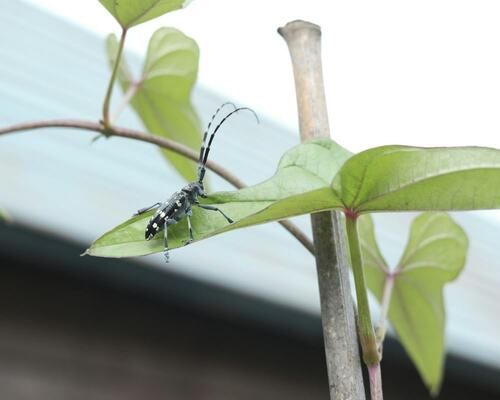The Ultimate Guide to Tree Pest Identification
Introduction
To grow and maintain beautiful, healthy, productive trees, you must know how to protect them from pests. Tree pests can cause significant damage to your trees, making them sick and even killing them in some cases. That’s why it’s so important to know how to identify tree pests and effectively address the problems they cause.
Read on to learn how to identify the common insects that cause tree damage and how to implement proven pest control methods.
Common Tree Insects and Their Damage
The most common tree pests can be categorized into three groups: sap-sucking, defoliators, and wood borers. Each category of insect does a specific type of damage that you can learn to identify so you can narrow down what the problem is.
Sap-Sucking Insects
Aphids

Aphids Cluster Together on a Leaf – Photo by Kelly on Pexels
These tiny insects consume the sap within tree leaves and stems. As they digest the sap, they leave behind a stick syrup commonly referred to as “honeydew.” It’s common to only see a few aphids at first.
Their small size can be disarming and deceiving because it usually doesn’t take long for hundreds to show up. Enough of these pests can stunt the growth of leaves and lead to curled, yellow leaves that are obviously abnormal.
Common signs of an aphid infestation include aphids under the leaves and sooty mold , which is attracted to honeydew.
Scale Insects
Scale insects like to eat the inner part of tree bark. Once they eat enough of the inner bark, it can lead to yellow leaves and stunted growth. Left unchecked, scale insects can eventually cause limb dieback and kill a tree.
The easiest way to spot scale insects is by identifying the colorful mounds they develop on twigs and leaves. They can also attract sooty mold, which you can use to identify the pest.
Spider Mites
Spider mites are eight-legged and therefore classified as arachnids, like spiders and ticks. Unlike most spiders, spider mites don’t offer much benefit to gardens and can instead cause significant damage to trees. They suck the chlorophyll out of tree leaves, leaving behind little white dots or stipples.
When enough spider mites are feeding on a tree, the leaves will start to yellow and drop off. Spider mites are quite small. It can be helpful to use a piece of white paper under a withered stem to catch them and see them move.
Defoliators
Spongy Moth

A Spongy Moth Resting on a Leaf
The spongy moth (formerly known as the gypsy moth ) is somewhat famous among tree growers due to the extensive damage it causes to forests. Since 1980, it has defoliated more than a million forested acres in the U.S.
In the spring, the moths will lay masses of eggs, which hatch into ravenous larvae—caterpillars—that eat away at leaves. They are particularly fond of hardwoods like oak and maple.
You can spot the yellowish egg masses on tree trunks during springtime. A few of these pests can cause withered leaves, while large numbers of them can completely strip trees bare of leaves.
Eastern Tent Caterpillar
In the eastern U.S., tent caterpillars focus on eating the leaves of hardwood shade trees like aspens, oaks and sugar maples.
You can spot the large silken tents they leave on tree branches when the pests are present. They can stunt the growth of trees and strip away large amounts of leaves. Spring is the season when these caterpillars emerge to wreak havoc, so start keeping an eye out for signs of them as the season begins.
Western Tent Caterpillar
Similar to the eastern version, the western tent caterpillar is most easily identified by its large silken tent on tree branches. They start to emerge in mid to late spring with a multi-larvae colony living in a single tent. As they feed and grow, the tent expands.
This caterpillar likes to eat the leaves of poplar, quaking aspen, cottonwood, and fruit trees throughout the western U.S.
The first sign of an infestation tends to be brown and shriveled foliage at the tips of tree branches.
Wood Borers
Asian Longhorn Beetle/Borer

An Asian Longhorn Beetle on the Edge of a Leaf – Photo by Seiya Maeda on Unsplash
As the name implies, this beetle did not originate in the U.S. It only became widely known in the late 1990s in Brooklyn, NY, as it spread through tree populations, causing extensive damage. Now it has been identified in at least fourteen states and will likely spread to more in the coming decades.
These boring beetles eat into the tree, causing damage deep into the tree and eventually causing it to come apart.
You can often identify this pest by its pencil-shaped exit holes and little piles of sawdust at the base of the tree. The damage caused by the beetles causes leaves to droop or turn yellow before the tree eventually dies.
Bark Beetles
Bark beetles love to burrow through bark. Unlike the Asian longhorn borer beetle, bark beetles don’t cause extensive structural damage to their hosts. However, they do bring along a variety of diseases which often sicken and sometimes kill the tree.
There are numerous types of bark beetles , some of which prefer conifers while others prefer hardwoods. As the beetles go from tree to tree, they bring along spores and spread disease.
These beetles often leave white or brown blobs of sap on the outside of the tree. With conifers, they can cause reddish-brown needles starting at the top of the tree.
Emerald Ash Borer
These borers kill millions of ash trees year after year. They are very small and hard to see on their own, but you can spot their S-shaped feeding galleries on infested ash trees.
Symptoms of an infestation include crown dieback and yellow foliage.
How to Identify Tree Pests

Tent Caterpillar Infestation on a Bush – Image by Scott from Pixabay
Part of arboriculture —the cultivation, management, and study of trees and similar plants—is learning signs of common tree insects and their damage. Before you can treat an infestation, you need to know what is causing it.
There are two main ways to do this: find the actual insects and identify them, or find signs that the insects leave behind. For example, if you see a large cluster of aphids under a leaf, you immediately know what you are dealing with. But if you can’t see the pests, as with spider mites, you need to know what signs they leave and use those to identify the problem.
Remember, the best way to spot tree pests is to see when something has changed with the tree. That means getting familiar with each tree and what it looks like from day to day. Spend time with your trees, and you will get a feel for when something changes.
Here are some of the simplest, most useful methods for identifying pests:
1. Look for insects.
Sometimes, you can quickly spot insects that look suspicious. A single insect might not be cause for concern. But if you see a large grouping of them—say 10, 20, or hundreds—it’s a sure sign of a problem.
Although it can be frustrating to identify a mass of pests, in a way, you can consider yourself lucky. If you see the pests, you can quickly identify them and deal with them promptly.
2. Search for damage to the tree.
Often, this is the first type of evidence you will encounter that shows that you have an insect problem. You might notice yellowing leaves, stunted leaf growth, or damage to limbs. Each type of insect leaves its own kind of damage.
If your conifer has a bunch of holes in its bark, you probably have a bark beetle problem. If the leaves on your tree are withered, you might have a spider mite issue. Over time, you will get better at spotting damage and knowing what is likely to have caused it.
3. Identify other evidence of insects (insect nests, waste products, etc.).
The last common sign of insect infestations is evidence on or around the tree. The tent caterpillar is a great example of this. When you see tents start popping up in the branches of your hardwoods, you can quickly identify the issue. Aphids leave behind honeydew. Borers drop sawdust as they travel inward.
If you are lucky, you can spot this kind of evidence before the tree starts to show significant damage and knock out the insects early.
Comparing Tree Pest Prevention Methods

A Comparative Chart of Tree Pest Control Methods
FAQ
1. What’s the easiest way to identify insect infestations?
It depends on your experience level. If you have some knowledge of common pests and signs, you will likely spot problems early on. But if you are new to this, the quickest and most surefire identification method is to call in a tree specialist.
2. Will an insect infestation kill my tree?
Unless the infestation has been going on for a while, you can usually save your trees. It’s all about spotting problems early and using the right tools to knock out the pests.
3. How long does it take to treat an infestation?
How long treatment takes depends on multiple factors, like how advanced it is, how healthy the tree is, and whether you use the right treatment for the problem.
Need Help with Your Trees? Contact Us!
Our team is standing by to help you identify and treat infestations and other tree problems. Please contact us today to schedule an appointment!


